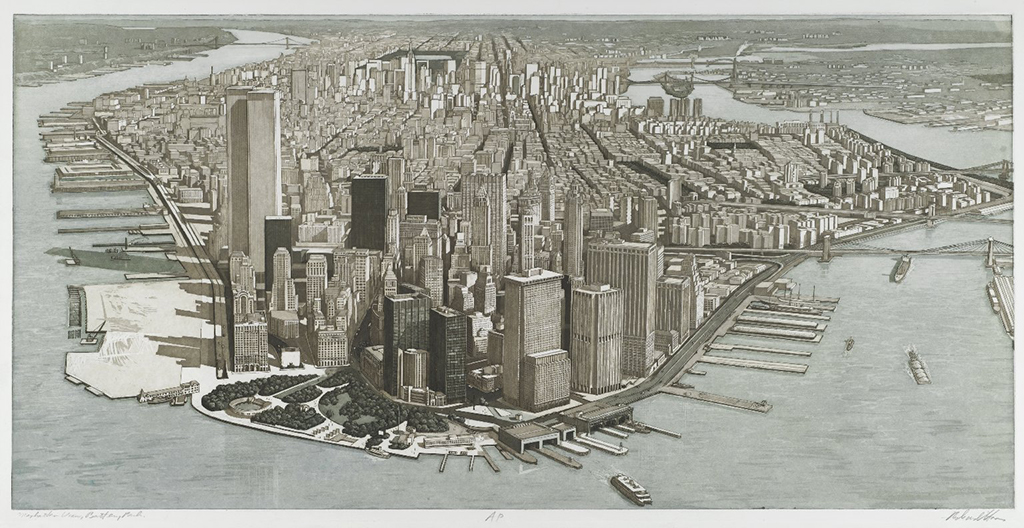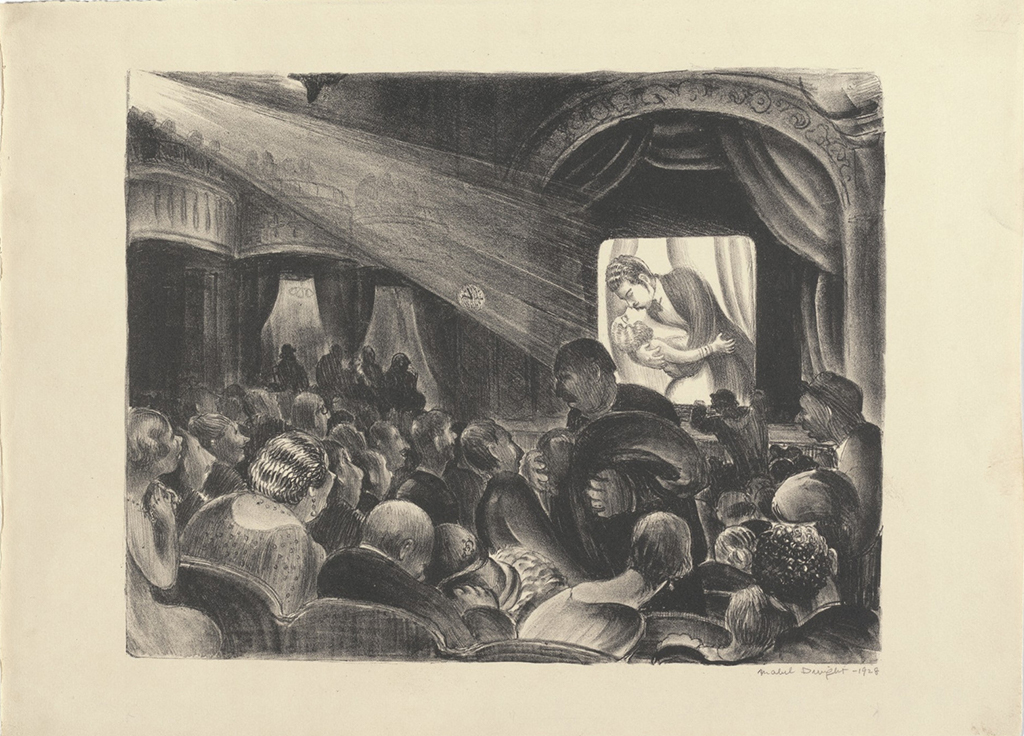We Love New York
As New York City faces the Covid-19 pandemic, our community has come together via myriad acts of neighborly service, along with the tireless efforts of healthcare workers, grocery workers, delivery people, and so many more. The daily push for solidarity has shined a light on the constant resilience of a city that has served as a source of inspiration for many throughout the years. We love New York, and in this spirit we look to some of the artworks our artists created in the city’s honor.

Etching with aquatint, Image: 21 1/4 x 42 3/4 inches (54 x 108.6 cm), Edition of 50, Publisher: Brooke Alexander Inc, Collection: Brooklyn Museum

Etching
Image: 8 x 5 inches (20.3 x 12.7 cm)
Edition of 60
Collections: Delaware Museum, MoMA

Mezzotint
41 1/2 x 29 1/2 inches (105.41 x 74.93 cm)
Edition of 90
Collections: Blanton, FAMSF, Fitzwilliam Museum, MIA, National Gallery,
Washington DC, Whitney, Wichita Art Museum

Lithograph
Image: 9 x 11 5/8 inches (22.9 x 29.5 cm)
Paper: 10 3/8 x 13 inches (26.4 x 33 cm)
Edition of 50
With her usual eye for satire, Mabel Dwight depicts a crowded movie theater, in which a man picks up his coat and hat and decidedly pushes his way through the audience before the film is over. The audience members sitting behind him twist and stretch their bodies so that they can watch the final close up of two lovers passionately embracing, which was typically the final scene of films in this era. A man in the audience falls asleep as a woman behind him swoons at the silver screen.
A deceptively casual view on daily indignities of modern life, it is important to consider the context in which this lithograph is situated. In 1928, cinema was a new medium and social phenomenon that was indicative of an evolving, modernized society. The moving picture’s advent as an art form and channel for mass entertainment heralded an age of new technologies, changing social structures and urbanity. Though the scene Dwight depicts here—a man rudely encumbering a view at the cinema—might seem like a familiar issue in this age, it was one that, in context, implied the unstoppable progression of modernity and rapidly accelerating social change.
Collections: Bibliothèque Nationale, Fogg, MoMA, Philadelphia, Whitney, Wolfsonian, Yale

Lithograph
Image: 9 5/16 x 15 15/16 inches (23.6 x 40.5 cm)
Edition of 85
Collections: Cleveland Museum, Met, MoMA, PAFA, RISD

Color monotype
30 x 22 inches (76.2 x 55.9 cm)
Publisher: Shark's Ink

Color monotype
30 x 22 inches (76.2 x 55.9 cm)
Publisher: Shark's Ink

Watercolor, ink, and collage
12 3/4 x 9 3/4 inches (32.4 x 24.8 cm)
Her first major print of the 1990s, Jacquette focused on her own backyard which she translated to silkscreen through the eyes of a longtime New Yorker. From a composite of views that include the artist’s own window, Chelsea is based on the intersection of 28th Street and 6th Avenue and the surrounding neighborhood, where Jacquette has lived since 1968. The scene is not a literal interpretation of the city. Jacquette chooses to change, manipulate, and delete physical buildings in order to form an effective, recognizable, yet ultimately imagined composition. While her elevated viewpoint suggests verticality—the ordered stacking of windows, singular tops of water towers, and the clinging, skeletal frame of a fire escape—this upward movement is tempered by a central wave of undulating, horizontal rooftops and the insertion of a bright, bustling city intersection.
Publisher: Mary Ryan Gallery
Collections: Cleveland Museum, Harn Museum, MoMA, Whitney

Silkscreen in 28 colors
36 x 31 3/4 inches (91.4 x 80.6 cm)
Edition of 75

Etching and aquatint , 16 x 42 5/8 inches (40.6 x 108.3 cm), Edition of 75

Lithograph, Paper: 12 3/4 x 8 3/4 inches (32.4 x 22.2 cm)
This impression from early edition of 15 printed in 1929, a later edition of 10 (numbered I-X) was printed in 1972
Known for his work capturing a burgeoning urban American landscape, Louis Lozowick was deeply fascinated by the rapid evolution of New York City’s skyline. He was a pioneer of Precisionist and Constructivist aesthetics, and was fascinated by the dynamic modernism of American bridges and skyscrapers. Born in Ukraine, Lozowick first emigrated to the United States in 1912. In this print, Lozowick offers us a glimpse of Madison Avenue as it looked in 1929. Employing the visual indicators of modernity, Lozowick draws out his view of the city in rhythmic angles and patterns, interrupted by a smattering of automobiles and a water tank in the foreground. The tone is one of hope for America’s industrial and urban future—it is a call to action that was effectively answered in subsequent years.
Collections: Smithsonian, Yale

Screenprint Image: 44 1/2 x 71 1/2 inches (113 x 181.6 cm)
Paper: 46 7/8 x 74 13/16 inches (119.1 x 190 cm)
Edition of 100
Publisher: Parasol Press
Collections: Addison Gallery at Phillips Academy, MIA, Tate

Screenprint Image: 44 1/2 x 71 1/2 inches (113 x 181.6 cm)
Paper: 46 7/8 x 74 13/16 inches (119.1 x 190 cm)
Edition of 100
Publisher: Parasol Press
Collections: Addison Gallery at Phillips Academy, MIA, Tate

Woodcut
Image: 12 x 11 inches (30.5 x 27.9 cm)
Edition of 60

Woodcut
Image: 12 x 11 inches (30.5 x 27.9 cm)
Edition of 60
Based on a painting and storybook of the same name, Faith Ringgold’s Tar Beach tells the story of a young African-American girl in New York, whose dreams of flight provide her with a sense of personal freedom and power over the city. In the story of Tar Beach, Cassie Lightfoot and her brother lounge on the rooftop of their apartment building in the summer, just as many New Yorkers trying to escape the heat before air conditioning. There, she spins a tale in which she can claim ownership over various city bridges and skyscrapers by flying over them. Via the act of imagined flight, Cassie escapes the distressing daily realities that a young black girl in 1939 Harlem would inevitably have had to face. Cassie’s dreamy domination of New York City is set only 76 years after the Emancipation Proclamation and 15 years before Brown vs Board of Education.
In a 1994 interview, Ringgold speaks of her own father and mother who “started out together, you know on the rooftop, in the twenties, playing their violins, going to church and with their dreams. And then they got married, they had three kids and my father got stuck in a dead-end job. […] He didn’t have any choices and that’s what [Tar Beach] was about—it’s about not having choices.”
In this woodcut, the viewer is afforded a glimpse Cassie and her brother flying over the city—the George Washington Bridge, dazzling and bright, theirs for the taking. Ringgold’s signature line “Anyone can fly” is perfectly captured by this image.
Publisher: Mulberry Press
Collections: MoMA, Cornell Museum at Rollins College

Drypoint
Image: 10 3/8 x 9 inches (26.4 x 22.9 cm)
Edition of 100, early impression
Collection: Library of Congress

Etching
Image: 11 x 8 1/2 inches (27.9 x 21.6 cm)
Edition of 40
Collections: Crystal Bridges, Met, Smithsonian
Chrysler Building Flanked by High Rise Buildings II is a strikingly linear depiction of Midtown Manhattan architecture. Jacquette studied the building from a 20th-floor penthouse on East 37th Street. Combining gridded line work with varied grooves and notches, this latest woodcut is a powerful rendering of structure, light, and reflection. Rendered during twilight, the print plays with the language of New York through the vocabulary of lines, dashes, and cuts that Jacquette has built. A surprising view of the Chrysler building, this print is one of three images Jacquette completed in 2009 looking up at her subjects. This shift in perspective is one that Jacquette has been exploring as she is increasingly interested in being in the middle of a view. Like the majority of her woodcuts, which Jacquette typically spends a year or more hand-cutting, it is printed in black ink on Japanese Okawara paper. She prefers this material for its natural contrast and ability to smoothly absorb the dense ink.
Publisher: Mary Ryan Gallery
Collections: Center for Maine Contemporary Art, Palmer Museum at Penn State

Woodcut on Okawara
35 5/8 x 23 1/2 inches (90.5 x 59.7 cm)
Edition of 75

Etching
Image: 9 1/8 x 10 3/16 inches (23.2 x 25.9 cm)
Edition of 50
Collections: FAMSF, Met, RISD, Yale

PWAP Lithograph
Paper: 13 3/4 x 8 3/4 inches (35 x 22.2 cm)
Edition of 10
This is a rare print created as part of the Public Works of Art project (PWAP). The PWAP was a program created under President Franklin Roosevelt to employ artists, as part of the New Deal, during the Great Depression. As part of the New Deal and the WPA (Works progress administration), the PWAP put over 3,700 artists to work, creating paintings, prints, sculptures, drawings, photographs and murals. Louis Lozowick was one of the artists on the PWAP where he also was employed to supervise other artists.
Collection: Smithsonian
An avid practitioner of yoga, de Brunhoff began his meditative practice while living in Paris, and this habit translated into a daily routine for over 50 years. In 2002, de Brunhoff combined the art of yoga with another of his lifelong passions: recounting the many adventures of Babar the Elephant, a saga that he began in 1946 with the publication of his first Babar book. In Babar’s Yoga for Elephants, Babar instructs elephants on the practice of yoga, and is depicted stretching his limber body in various yoga positions all around the world. In lieu of following a narrative arc, Babar’s Yoga for Elephants is a how-to yoga book that illustrates poses using pachyderms rather than people. In this drawing, two elephants find inner peace in the usual hustle and bustle of Times Square, exemplifying the meditative power of yoga.

Watercolor, pen and ink on paper
Image: 8 1/2 x 12 inches (21.6 x 30.5 cm)

Lambda print
Each panel: 35 x 60 inches (88.9 x 152.4 cm)
Full dimension: 35 x 122 inches (88.9 x 309.9 cm)
Edition of 5

Color aquatint
Image: 20 x 26 3/4 inches (50.8 x 67.9 cm)
Paper: 25 x 30 3/4 inches (63.5 x 78.1 cm)
Edition of 30
Publisher: Paulson Fontaine Press

Color aquatint
Image: 20 x 26 3/4 inches (50.8 x 67.9 cm)
Paper: 25 x 30 3/4 inches (63.5 x 78.1 cm)
Edition of 30
Publisher: Paulson Fontaine Press
Inspired by the Beatles landing at JFK Airport for their first US tour in 1964, Mondrian Meets the Beatles incorporates an iconic image from American Pop culture with the recognizable hues of Dutch painter Piet Mondrian. Ezawa explained his reasoning behind the intersection of the band and the artist: “The Beatles and Mondrian are both pioneers in their respective fields. Mondrian’s work radically impacted the trajectory of painting in the 20th century. The Beatles revolutionized rock and pop. Both of them also have a very classic style that I appreciate.”